The external fund manager backed by Berkshire Hathaway's Charlie Munger, Li Lu, makes no bones about it when he says 'The biggest investment risk is not the volatility of prices, but whether you will suffer a permanent loss of capital.' So it seems the smart money knows that debt - which is usually involved in bankruptcies - is a very important factor, when you assess how risky a company is. We can see that Li Auto Inc. (NASDAQ:LI) does use debt in its business. But the more important question is: how much risk is that debt creating?
Why Does Debt Bring Risk?
Generally speaking, debt only becomes a real problem when a company can't easily pay it off, either by raising capital or with its own cash flow. Ultimately, if the company can't fulfill its legal obligations to repay debt, shareholders could walk away with nothing. While that is not too common, we often do see indebted companies permanently diluting shareholders because lenders force them to raise capital at a distressed price. Of course, plenty of companies use debt to fund growth, without any negative consequences. When we think about a company's use of debt, we first look at cash and debt together.
View our latest analysis for Li Auto
What Is Li Auto's Net Debt?
You can click the graphic below for the historical numbers, but it shows that Li Auto had CN¥8.72b of debt in December 2023, down from CN¥9.62b, one year before. However, its balance sheet shows it holds CN¥103.3b in cash, so it actually has CN¥94.5b net cash.

How Strong Is Li Auto's Balance Sheet?
We can see from the most recent balance sheet that Li Auto had liabilities of CN¥72.7b falling due within a year, and liabilities of CN¥10.1b due beyond that. Offsetting this, it had CN¥103.3b in cash and CN¥143.5m in receivables that were due within 12 months. So it actually has CN¥20.5b more liquid assets than total liabilities.
This short term liquidity is a sign that Li Auto could probably pay off its debt with ease, as its balance sheet is far from stretched. Simply put, the fact that Li Auto has more cash than debt is arguably a good indication that it can manage its debt safely.
Although Li Auto made a loss at the EBIT level, last year, it was also good to see that it generated CN¥7.4b in EBIT over the last twelve months. When analysing debt levels, the balance sheet is the obvious place to start. But ultimately the future profitability of the business will decide if Li Auto can strengthen its balance sheet over time. So if you want to see what the professionals think, you might find this free report on analyst profit forecasts to be interesting.
Finally, while the tax-man may adore accounting profits, lenders only accept cold hard cash. Li Auto may have net cash on the balance sheet, but it is still interesting to look at how well the business converts its earnings before interest and tax (EBIT) to free cash flow, because that will influence both its need for, and its capacity to manage debt. Over the last year, Li Auto actually produced more free cash flow than EBIT. That sort of strong cash generation warms our hearts like a puppy in a bumblebee suit.
Summing Up
While it is always sensible to investigate a company's debt, in this case Li Auto has CN¥94.5b in net cash and a decent-looking balance sheet. And it impressed us with free cash flow of CN¥44b, being 597% of its EBIT. So we don't think Li Auto's use of debt is risky. There's no doubt that we learn most about debt from the balance sheet. But ultimately, every company can contain risks that exist outside of the balance sheet. For example - Li Auto has 2 warning signs we think you should be aware of.
If, after all that, you're more interested in a fast growing company with a rock-solid balance sheet, then check out our list of net cash growth stocks without delay.
New: AI Stock Screener & Alerts
Our new AI Stock Screener scans the market every day to uncover opportunities.
• Dividend Powerhouses (3%+ Yield)
• Undervalued Small Caps with Insider Buying
• High growth Tech and AI Companies
Or build your own from over 50 metrics.
Have feedback on this article? Concerned about the content? Get in touch with us directly. Alternatively, email editorial-team (at) simplywallst.com.
This article by Simply Wall St is general in nature. We provide commentary based on historical data and analyst forecasts only using an unbiased methodology and our articles are not intended to be financial advice. It does not constitute a recommendation to buy or sell any stock, and does not take account of your objectives, or your financial situation. We aim to bring you long-term focused analysis driven by fundamental data. Note that our analysis may not factor in the latest price-sensitive company announcements or qualitative material. Simply Wall St has no position in any stocks mentioned.
About NasdaqGS:LI
Li Auto
Operates in the energy vehicle market in the People’s Republic of China.
Excellent balance sheet with reasonable growth potential.
Similar Companies
Market Insights
Community Narratives



